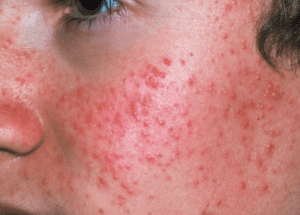Acne: Oily skins are more prone to acne and breakouts than dry skin. Acne is noticed more on the face but it also appears on other parts of the body. Before we talk about the types of acne and how to treat them, let’s first understand the mechanism – how they come about.
Beneath the skin surface, there are many hair follicles from which hair grows. Also, there are sebaceous glands at the base of each hair follicle. These sebaceous glands produce sebum in form of oil through the narrow channels first, into the lumen of the hair follicle and then onto the skin surface. Acne may arise due to any of the reasons below:
- An increased function of the sebaceous glands at the base of hair follicles. The increased sebum production is directly related to the increase in adrenal androgen production (sex hormones). These hormones are produced in both genders, but women produce them to a lesser extent. That is why acne develops at puberty in adolescents.
- Keratosis of the epithelium within the follicle. The surface of each hair follicle from the inside is covered with layers of epithelial cells. The increase in the rate of epithelial cells leads to the growth in the number of exfoliated, dead cells in the lumen. The increase in sebum production and increase in the number of exfoliated cells result in the formation of obstructive particles that clog the pores of the skin. The congestion leads to the fact that sebum can’t get out thus, it accumulates in the lumen of the hair follicle. Enclosed space with a nutrient medium inside is the ideal place for the development of infection, so bacteria trapped inside hair follicle from the skin surface begins to multiply intensively there.
Such a process leads to the development of inflammation in and around the follicle. Inflammation for an extended period can occur without the formation of pus, in this case, the acne is called a papule. Papule looks like a red, inflamed bump on the skin surface. Papules can disappear without a trace, but they usually transform into pustules. A pustule is already a classic pimple with pus inside. Also, in the more severe forms of acne more serious inflammatory issues can be developed, forming knots and cysts. The knots are tight, painful papules of large size, within which there is also no pus. When trying to extrude deeply located knot in the skin of acne, you get the pus penetrated deeper in the tissue, this can lead to a Cyst.
From this explanation, you can easily identify the different types of acne viz. Papules, Pustules, Knots and Cysts. We also have a fifth type known as Blackheads. They are very common and may appear open or closed. Open blackheads look like black dots in the pores of the skin and closed ones look like bumps on the surface of the skin.
Now, you’ve understood the cause of your acne problem, let’s look at various ways of treating acne. Bear in mind, that the treatment also depends on the type of acne you’re suffering from, having listed the different types above.
Acne Treatment
To achieve any noticeable improvement, one will need up to 4 weeks of treatment. The standard course of therapy is about six weeks. However, the persistent acne treatment may take up to four months (and sometimes longer) to get a good result and not only to get rid of acne but post-inflammatory pigmentation of the skin.
- First, you need to visit a dermatologist to confirm your acne and ascertain the right treatment. You also need to find out what your skin is allergic to, to avoid redness and irritation.
- The next step is to maintain a good personal hygiene. The preliminary for your skin will include: daily skin care and use of mild skin care products. Try to avoid products that irritate your skin.
- Treatment products with benzoyl peroxide, azelaic acid or gel with the antibiotic can be carried out two times a day or based on doctor’s prescription: this can be 1 product or a combination of 2 drugs.
- Use gels or lotion instead of creams. Creams are more suitable for dry skin.
- Use a light makeup. Cosmetics care products for the skin often result in clogging of pores and formation of acne. You should only use light moisturizers and water-based makeup products.
Getting rid of post-inflammatory pigmentation of the skin (acne scars)
At times, the acne leaves behind ugly scars and spots after treatment. There are some beauty products you can use too remove these scars, please avoid bleaching creams. Treatment can include both surgical and conservative procedures.
Methods of getting rid of red spots after acne will be significantly different depending on how serious it looks, you can use:
- Professional and home chemical peels;
- Skin polishing with abrasives.
There are several methods of harsh skin resurfacing:
- the method of microdermabrasion;
- the method of dermatophyte;
- the use of skin resurfacing lasers.
How long do the results last after treatment?
After you have cleared the face of acne, blackheads and blemishes, acne can appear again after some time, say, 4 – 5 years or even less. You may need to adjust your diet and depending on your skin type, you may also need to continue with a regular maintenance therapy.